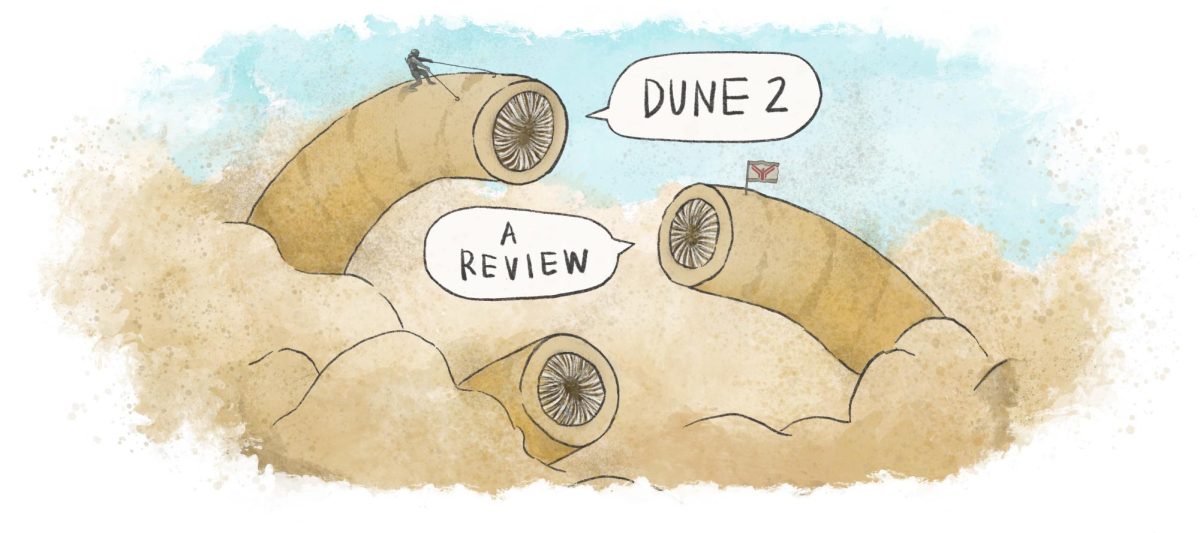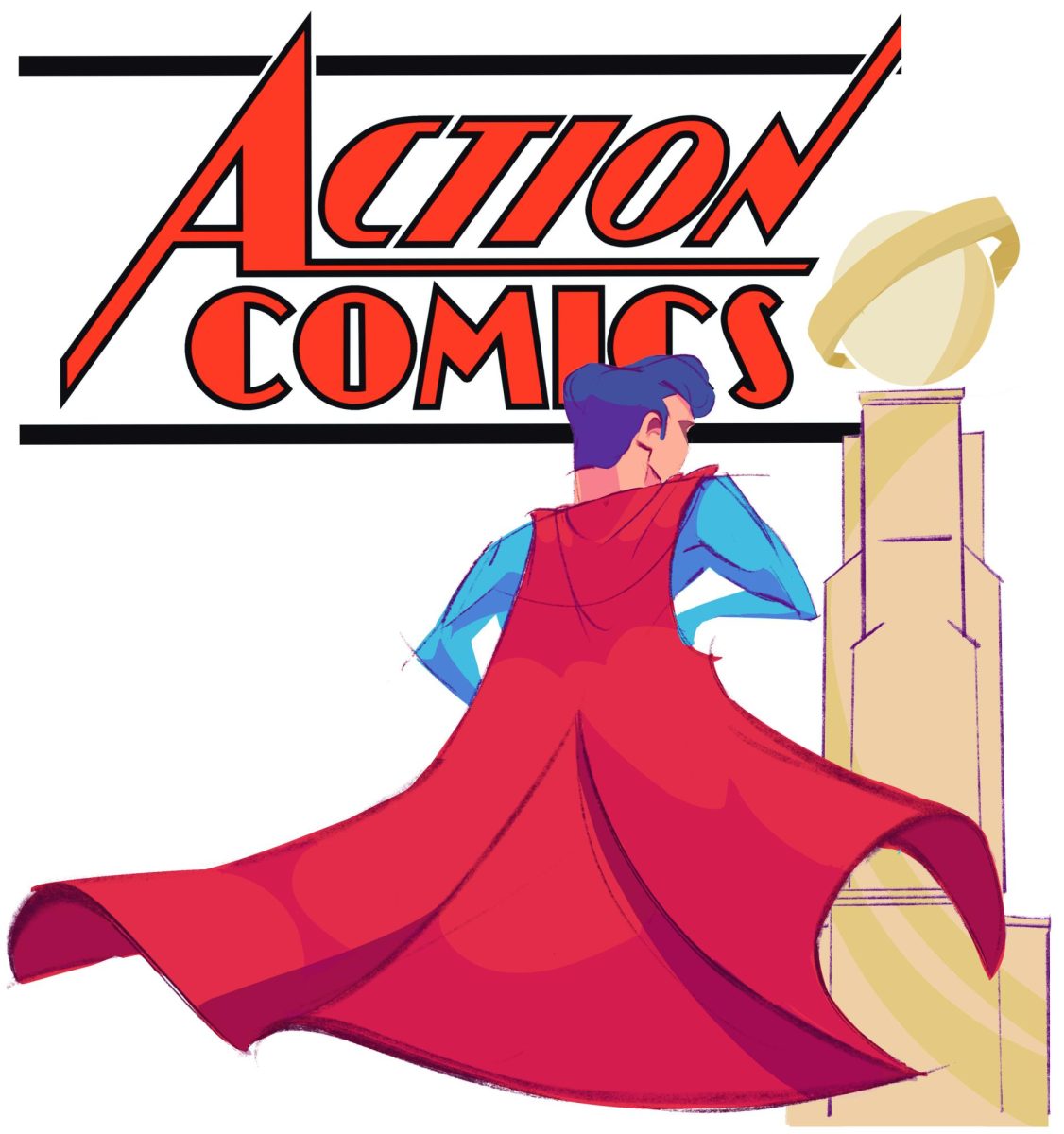In the world of cinematic adaptations, very few are as daunting a task to take on as Frank Herbert’s intricate science fiction novel, “Dune.” Denis Villeneuve, co-producer and director of the recent “Dune” film adaptations, ambitiously and satisfyingly honors Herbert’s writing and captivates audiences by visually bringing to life the profound world and storyline of the nearly 600 page book.
The Duniverse sends its audience into a world set thousands of years in the future, highly advanced yet relapsing simultaneously. Here, noble houses such as the Atreides and Harkonnens compete for control over the desert planet of Arrakis.
Swiftly beginning mid-rebellion and post Harkonnen ambush on the House of Atreides, where 2021’s “Dune” left off, “Dune: Part Two” digs deeper into the social, economic and political complexities of Herbert’s elaborate universe. The film immerses viewers to understand the gravity of every group so far in the Duniverse’s hierarchy with their dilemmas and end goals. At its core, the film maintains the narrative themes of imperialism, power, politics, spirituality and the human condition. It is truly a brilliant expansion upon the first movie.
Director’s Take
One of the film’s most eye-catching elements is its visual grandeur. Straight from the theater seats, viewers are transported into the dry and harsh land of Arrakis. With Villeneuve’s direction and Greig Fraser’s Oscar-winning cinematography skills, the minds behind the film put together an altogether mesmerizing sight to behold. From the dusty atmosphere of the sand dunes to the grayscale Harkonnen arena sequence made with an ingenious 3D camera rig and a special light system to create an infrared effect, this film would not have been as thrilling if it were not for the breathtaking visuals.
Surreal Performances
Part of the film’s success can be attributed to the acting itself. Each member of the ensemble cast presented a new life and delivered depth within their characters. Timothée Chalamet executed the emotional turmoil and journey of Paul Atreides incredibly well and the vulnerability that protrudes through battles he fights within himself.
The character adjustment of Chani (Zendaya), was a strong choice which enhanced the defiant and respected persona she possesses, not only augmenting but also justifying the rebellious convictions and beliefs she fervently pushes. The chemistry between the two is undeniable.
Characters such as Lady Jessica (Rebecca Ferguson), and Stilgar (Javier Bardem), bring a sense of moral ambiguity to their roles revealing more about their raw beliefs and the lengths they would go to in order to ensure their place and power.
Newly introduced characters delivered further intrigue, such as the sadistic Feyd-Rautha (Austin Butler), magnetizing viewers with his intense performance that truly embodied the character’s unsettling spirit. While Princess Irulan (Florence Pugh), though lacking in dimension as her monologues are solely conversations on politics, has fortunately brought the character’s noteworthy internal conflicts and faith in humanity into light, more than the novel ever did.
The dominance of A-list actors in productions tend to create a subtle feel of artificiality and cheesiness due to overexposure or unrealistic portrayal. However, casting so far has not failed for Villeneuve’s “Dune” adaptations. Overall, the performances in “Dune: Part Two” serve justice to Herbert’s iconic and dynamic characters while production still takes creative liberties of their own, making the film a truly immersive and hypnotizing experience.
Stunning Production
Technical elements such as the sound, and music by composer Hans Zimmer, were a finishing touch on fabricating the various atmospheres the film explores. Zimmer’s music enhanced every scene with dense and punchy designs, as the music carried harmonious balance between hushed and plaintive melodies and cold, thunderous ones. The score indeed is a captivating element of the film’s production and leaves the minds of the audience swimming in its instrumentals.
The film’s extravagant lighting and camera work are noteworthy components of its visual storytelling. The sun-drenched and warm environments of Arrakis and contrast the dimly lit and monochromatic interior stronghold of Geidi Prime. The flawless CGI, panoramic aerial shots and swift camera movements capture the epic scope and scale of Herbert’s almost too grand to imagine universe. The audience is constantly evoked with feelings of awe due to such vivid landscapes.
A World Fully Realized
Going to the movie theater to watch all 2 hours, 46 minutes of “Dune: Part Two,” I was skeptical about how certain far-fetched and abstract aspects of the novel’s storyline would be portrayed. I was completely engrossed with the storyline, approach and visuals of the film.
Though Villeneuve cuts out a few scenes and adds his own twists to some storylines and arcs, he nonetheless captures the novel’s essence. Due to the novel’s distinct prose and tendency to draw out scenes, every minute of this film is minutely composed and challenges the critiques of those who find scenes in both the book and movies to be too lengthy and unnecessary.
Watching this movie in theaters reminded me of why going to the movies adds so much to the complete cinematic experience. Regarding the film as a whole and its execution of the rest of Herbert’s first book in the Dune saga, Villeneuve and crew have crafted a film that respectfully tips a hat at the author’s timeless work as they dare to pursue wondrous artistic challenges and directions of their own.









